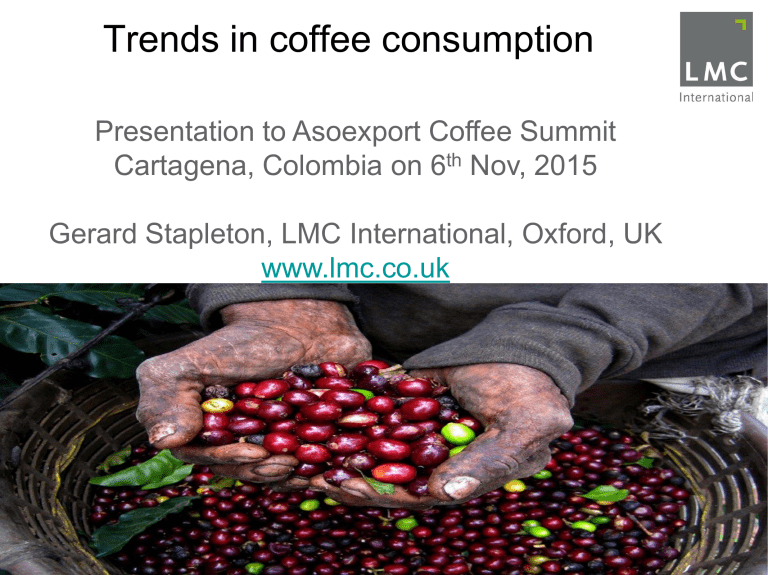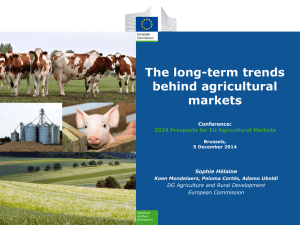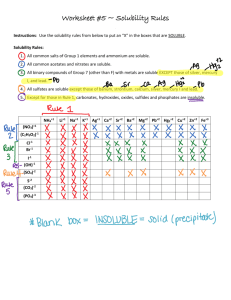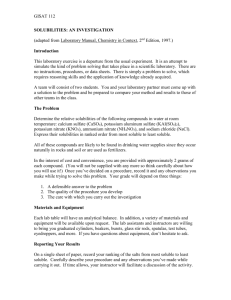
Trends in coffee consumption
Presentation to Asoexport Coffee Summit
Cartagena, Colombia on 6th Nov, 2015
Gerard Stapleton, LMC International, Oxford, UK
www.lmc.co.uk
Outline
• Emerging vs. mature markets
• Soluble consumption
• Outlook
Emerging vs. mature markets
In recent years, consumption growth has been
dominated by emerging markets
Consumption index (1990=100)
250
200
150
100
1990
1995
2000
Mature
2005
Emerging
2010
2015
Growth has been strong in both coffee
producing countries and non-coffee producing
countries
Consumption index (1990=100)
300
250
200
150
100
1990
1995
2000
Emerging (Non-producers)
2005
2010
Producers
2015
This has reduced the importance of mature
markets, although they are still the largest
segment of consumption
90
Consumption (mn bags)
80
70
60
50
40
30
20
10
0
1985
1995
Mature
2005
Producers
2015
Other Emerging
Over 2.5 mn bags are being added to
consumption each year (80% of this growth is in
the emerging markets)
Annual increase in consumption (mn bags)
1.4
1.2
1.0
0.8
0.6
0.4
0.2
0.0
Producers
Mature
1995-2005
2005-2015
Other Em erging
Rising incomes are driving this growth (along
with a growing middle class and urbanisation)
8.0
Germ any
7.0
Brazil
Consumption per capita
6.0
France
Greece
5.0
Poland
4.0
Japan
Australia
3.0
S Korea
UK
2.0
Russia
1.0
0.0
0
10,000
20,000
30,000
40,000
50,000
Income per Capita ($)
60,000
70,000
80,000
0
Finland
Sweden
Norway
Netherlands
Lebanon
Denmark
Slovenia
Austria
Croatia
Germany
Brazil
Cyprus
Switzerland
Israel
Belgium
France
Italy
Serbia
Greece
Hungary
Canada
Czech
Portugal
USA
Slovakia
Bulgaria
Poland
Algeria
UAE
Spain
Japan
NZ
Romania
Australia
Jordan
UK
Korea
Malaysia
Ireland
Taiwan
Colombia
Singapore
Saudi Arabia
Russia
Mexico
Ukraine
Ethiopia
Thailand
Morocco
Argentina
Philippines
Vietnam
Indonesia
Turkey
Chile
S Africa
Fiji
Egypt
India
Iraq
China
kg per year
but per capita consumption levels remain
relatively low
14
12
10
8
6
4
2
Consumption growth tends to follow an “S”
curve: slow start, rapid acceleration, stagnation
4.0
500
3.5
Imports ('000 tonnes)
400
350
3.0
Japan
2.5
300
2.0
250
200
1.5
150
1.0
100
0.5
50
0.0
0
1950 1955 1960 1965 1970 1975 1980 1985 1990 1995 2000 2005 2010 2014
Imports
Consumption per capita
Per capital consumption (kg per capita)
450
Tastes are also important, high soluble
consumption is linked to high per capita tea
consumption.
100%
90%
Australia
Russia
China
UK
80%
Chile
Soluble (%)
70%
60%
India
50%
40%
Japan
30%
20%
France
10% Germany
Brazil
US
0%
Finland
0.0
0.5
Canada
1.0
1.5
Per capita tea consumption (kg/annum)
2.0
2.5
Per capita consumption is higher in the coffee
producing countries than other emerging markets.
Producers have a “taste” for coffee.
3.5
Americas (p)
Per capita consumption (kg)
3.0
2.5
CE Europe
2.0
1.5
Africa (c)
1.0 Asia (p)
Asia (c)
0.5
Africa (p)
0.0
0
2,000
4,000
6,000
8,000
10,000
12,000
Per capita income ($)
14,000 16,000
18,000
Growth in emerging market demand has seen a
large increase in robusta demand, both as a
proportion of total consumption…
60%
Robusta proportion (%)
50%
40%
30%
20%
10%
0%
Mature
Producers
1995
2005
2015
Other Emerging
…and in absolute volumes. This is due to
growing conillon use in Brazil (until recently…)
and higher soluble consumption.
Consumption (mn bags)
30
20
10
0
1985
1995
Mature
2005
Producers
2015
Other Emerging
There is greater flexibility in terms of blend
formation in the mature markets. Least flexibility
in the coffee producing countries.
EU-28
100%
90%
80%
Imports %
70%
60%
50%
40%
30%
20%
10%
0%
2009
2010
2011
Washed
2012
Naturals
2013
Robusta
2014
2015 JanJul
In Japan, blends have been relatively stable
over the last three years
100%
90%
80%
Imports %
70%
60%
50%
40%
30%
20%
10%
0%
2009
2010
2011
Washed
2012
Naturals
2013
Robusta
2014
2015 JanSep
specialty proportion of consumption (%)
In the US, specialty coffee now accounts for over
one third of total consumption, compared to less
than 25% in 2010 (less than 10% in the late 1990’s)
35%
30%
25%
20%
2010
2011
2012
2013
2014
The growth in US specialty consumption has
sustained washed arabica imports…
100%
90%
80%
Imports %
70%
60%
50%
40%
30%
20%
10%
0%
2009
2010
2011
Washed
2012
Naturals
2013
Robusta
2014
2015 JanAug
… excluding specialty consumption, US mainstream
blends are more flexible in their formation.
100%
90%
80%
Imports %
70%
60%
50%
40%
30%
20%
10%
0%
2009
2010
2011
Washed
2012
Naturals
2013
Robusta
2014
2015 JanAug
Households owning single-serve brewer
Over 25% of US households now own single-serve
coffee brewers. According to the NCA most
owners consume more cups per day than nonowners.
30%
25%
20%
15%
10%
5%
0%
2005
2006
2007
2008
2009
2010
2011
2012
2013
2014
2015
600
90
500
75
400
60
300
45
200
30
100
15
0
0
Soluble
Espresso
Pods
Capsules
Total market
Segment ('000 tonnes, gbe)
Total market ('000 tonnes, gbe)
German consumption saturated, but espresso and
single-serve capsules remain growth segments.
Exports ('000 tones)
Italian R&G exports support strong growth in
espresso-based consumption
180
16%
160
14%
140
12%
120
10%
100
8%
80
6%
60
4%
40
2%
20
0%
0
-2%
2000
2002
2004
2006
Change in Exports
2008
2010
R&G Exports
2012
2014
Russian imports reflect consumption growth plus
increased stocks…
5.0
4.5
million bags
4.0
3.5
3.0
2.5
2.0
1.5
1.0
0.5
0.0
2004
2005
2006
2007
2008
Green
2009
R&G
2010
2011
Soluble
2012
2013
2014
Import Growth (same month 12 months ago)
… while Russian monthly total coffee imports
fluctuating in 2015, no clear sign of slowdown yet.
120%
100%
80%
60%
40%
20%
0%
-20%
-40%
-60%
2009
2010
2011
2012
2013
2014
2015
Change in Sales on same quarter 12 mnths
earlier
Starbucks comparable stores sales growth
accelerating in Americas region.
15%
10%
5%
0%
-5%
-10%
-15%
2006
2007
2008
2009
2010
2011
2012
2013
2014
2015
100%
6.00
90%
5.80
80%
5.60
70%
5.40
60%
5.20
50%
5.00
40%
4.80
30%
4.60
20%
4.40
10%
4.20
0%
4.00
1980
1985
Soluble %
1990
1994
1998
Canned/liquid %
2002
R&G %
2006
2010
2014
Soluble cups/day
Cups per day
Cups per day (%)
In Japan, recent consumption growth seen in R&G
and soluble segments.
22
10%
20
8%
18
6%
16
4%
14
2%
12
0%
10
-2%
GDP Growth
Consumption
GDP Growth (%)
Consumption (mn bags)
In Brazil, consumption growth has slowed in line
with economic growth.
Soluble markets
Global soluble consumption growth over 3% per
year between 2008 and 2013…
800
700
600
Consumption (tonnes)
500
400
300
200
100
0
2008
2009
2010
2011
2012
2013
North Africa
Africa
Middle East
North America
South America
EU
Eastern Europe
East Asia
India
China
ASEAN
Oceania
…with strongest growth seen in the emerging
markets (notably in China, Africa and ASEAN)
Oceania
ASEAN
China
India
East Asia
Eastern Europe
EU
South America
North America
Middle East
Africa
North Africa
0%
2%
4%
6%
8%
10%
12%
14%
Freeze-dried consumption growth over 5% per
year between 2008 and 2013.
200
180
160
'000 tonnes
140
120
100
80
60
40
20
0
2008
EU
2009
Eastern Europe
2010
2011
North America
2012
East Asia
2013
Other
Outlook
Slightly higher global consumption growth (~1.9%)
is expected in 2016, although this crucially
depends on economic growth prospects.
Annual Change in Consumption (%)
6%
5%
4%
3%
2%
1%
0%
Producing
Countries
2011
Americas
2012
Western
Europe
2013
Central &
Africa &
East Europe Middle East
2014
2015
Asia &
Pacific
2016
Soluble consumption is expected to continue
growing at 3% per year.
900
800
700
Consumption (tonnes)
600
500
400
300
200
100
0
2013
2014
2015
2016
2017
2018
North Africa
Africa
Middle East
North America
South America
EU
Eastern Europe
East Asia
India
China
ASEAN
Oceania
2019
Our longer-term forecasts point to global
consumption of ~180 mn bags by 2025/26.
180
160
140
mn bags
120
100
80
60
40
20
0
2014/15
2020/21
Western Europe
Producing Countries
Americas
Asia and Pacific
Central and Eastern Europe
Africa and Middle East
2025/26
Thank You
www.lmc.co.uk
Oxford (HQ)
4th Floor, Clarendon House
52 Cornmarket Street,
Oxford OX1 3HJ
UK
New York
1841 Broadway
New York, NY 10023
USA
T +44 1865 791737
F +44 1865 791739
info@lmc.co.uk
T +1 (212) 586-2427
F +1 (212) 397-4756
info@lmc-ny.com
Kuala Lumpur
B-03-19, Empire Soho
Empire Subang
Jalan SS16/1, SS16
47500 Subang Jaya
Selangor Darul Ehsan
Malaysia
T +603 5611 9337
Singapore
16 Collyer Quay #21-00
Singapore 049318
info@lmc-kl.com
info@lmc-sg.com
T +65 6818 9231
© LMC International, 2015
All rights reserved
This presentation and its contents are to be held confidential by the client, and are not to be disclosed, in whole or in
part, in any manner, to a third party without the prior written consent of LMC International.
While LMC has endeavoured to ensure the accuracy of the data, estimates and forecasts contained in this presentation,
any decisions based on them (including those involving investment and planning) are at the client’s own risk.
LMC International can accept no liability regarding information analysis and forecasts contained in this presentation.






